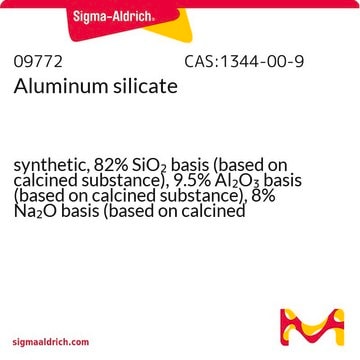556130
Bismuth
pieces, 1-12 mm, 99.999% trace metals basis
Synonyma:
Bismuth element, Bismuth-209
Přihlásitk zobrazení cen stanovených pro organizaci a smluvních cen
About This Item
Empirický vzorec (Hillův zápis):
Bi
Číslo CAS:
Molekulová hmotnost:
208.98
EC Number:
MDL number:
UNSPSC Code:
12141706
PubChem Substance ID:
NACRES:
NA.23
Doporučené produkty
vapor pressure
<0.1 mmHg ( 20 °C)
assay
99.999% trace metals basis
form
pieces
resistivity
129 μΩ-cm, 20°C
particle size
1-12 mm
bp
1560 °C (lit.)
mp
271 °C (lit.)
density
9.8 g/mL at 25 °C (lit.)
SMILES string
[Bi]
InChI
1S/Bi
InChI key
JCXGWMGPZLAOME-UHFFFAOYSA-N
Hledáte podobné produkty? Navštivte Průvodce porovnáváním produktů
General description
Bismuth (Bi) is a brittle, lustrous metal known for its unique properties and low toxicity. This product features a particle size ranging from 1-12 mm, a resistivity of 129 μΩ-cm at 20°C, and a density of 9.8 g/mL at 25 °C. Bismuth is recognized for its unique properties, including its expansion upon solidification, which makes it advantageous in casting applications. Its low melting point of 271 °C allows for easy processing, making it suitable for a range of material science applications. Our high-purity bismuth is characterized by an assay of 99.999% trace metals basis, ensuring exceptional quality and reliability for sensitive applications in electronics, material science, and research.
Application
- Research Update: Bismuth based materials for photovoltaics: This research update briefly summarizes the developments in bismuth materials for use in photovoltaics, focusing on bismuth-based perovskites and bismuth halides (Cates & Bernechea, 2018).
- Bismuth-based photocatalysts for solar energy conversion: This study reviews bismuth-based photocatalysts, which are gaining attention for their efficiency in solar energy conversion (Wang, Wang & Huang, 2020).
Storage Class
11 - Combustible Solids
wgk_germany
nwg
flash_point_f
Not applicable
flash_point_c
Not applicable
ppe
Eyeshields, Gloves, type N95 (US)
Vyberte jednu z posledních verzí:
Již tento produkt vlastníte?
Dokumenty související s produkty, které jste v minulosti zakoupili, byly za účelem usnadnění shromážděny ve vaší Knihovně dokumentů.
Zákazníci si také prohlíželi
Philip C Andrews et al.
Chemical communications (Cambridge, England), 49(28), 2870-2872 (2013-03-02)
Reaction of Bi(O(t)Bu)3 with aspirin (acetylsalicylic acid = aspH) in dry toluene results in the bismuth(III) complex, [Bi(O2C(C6H4)OAc)3]∞ 1 (O2C(C6H4)OAc = asp), minimum inhibitory concentration (MIC) against Helicobacter pylori ≥ 6.25 μg mL(-1), while the inclusion of a stoichiometric equivalent
Julie Pannequin et al.
The Journal of biological chemistry, 279(4), 2453-2460 (2003-10-08)
Although bismuth salts have been used for over two centuries for the treatment of various gastrointestinal disorders, the mechanism of their therapeutic action remains controversial. Because gastrins bind two trivalent ferric ions with high affinity, and because ferric ions are
A Slikkerveer et al.
Medical toxicology and adverse drug experience, 4(5), 303-323 (1989-09-01)
Inorganic bismuth salts are poorly soluble in water: solubility is influenced by the acidity of the medium and the presence of certain compounds with (hydr)oxy or sulfhydryl groups. The analysis of bismuth in biological material is not standardised and is
Shunbin Lu et al.
Optics express, 21(2), 2072-2082 (2013-02-08)
The third order nonlinear optical property of Bi₂Se₃, a kind of topological insulator (TI), has been investigated under femto-second laser excitation. The open and closed aperture Z-scan measurements were used to unambiguously distinguish the real and imaginary part of the
B Arnaud et al.
Physical review letters, 110(1), 016405-016405 (2013-02-07)
By means of first principles calculations, we compute the effective electron-phonon coupling constant G(0) governing the electron cooling in photoexcited bismuth. G(0) strongly increases as a function of electron temperature, which can be traced back to the semimetallic nature of
Náš tým vědeckých pracovníků má zkušenosti ve všech oblastech výzkumu, včetně přírodních věd, materiálových věd, chemické syntézy, chromatografie, analytiky a mnoha dalších..
Obraťte se na technický servis.







